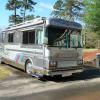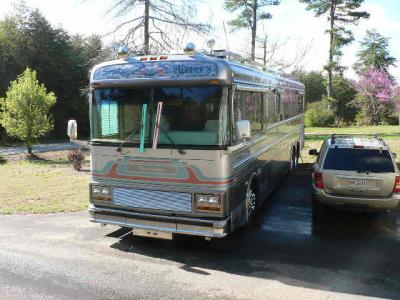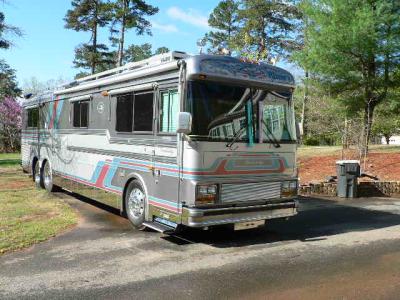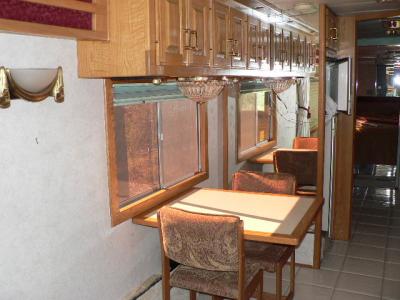-
Content Count
57 -
Joined
-
Last visited
-
Days Won
4
Posts posted by mpierce
-
-
110, 110, 110! (or 115V or 120V, but never 220/240). If you have a 30 amp coach you also have no reason to install a 50 amp circuit (it would be silly and of no benefit of any kind).
Unless at some point in the future you get a 50 amp RV.
-
Can you use either trailer by themselves? If you can has anyone done this and individually how do they tow?
Not quite sure what you are asking. Tandem tow trailers are only one trailer, not two. There is an extended tongue, with a platform on it for the MC ahead of the car.
-
Yes, he did. It was a bittersweet moment for them. They did not use it as much, and wanted to sell. Yet, very sad it had to go, and tough seeing it going down the driveway.
Thanks again, Leroy, for the great job you did to a 25 year old coach. I hope we will put it to good use for another 20 years or so, and be able to pass it on to someone else to enjoy.
At 48,000#, it is SOLID!
-
We went down to GA, and picked up the BluBird. Stayed two nights in it at Leroys, and he showed us a lot of features. Really nice for a 25 year old MH. But, they are built like a brick s***house.
Got it home on July 5th. Ran flawlessly on the 1700 mile trip. That 8V92 sure purrs!
-
I assume you did an oil test, and it is fuel in the oil? If so, you NEED to get it fixed asap. The fuel dilution quickly removes the lubrication qualities of the oil, and wear inside the engine goes up dramatically, and keeps increasing as the level of fuel increases. It is a BAD thing. May not be a cheap fix, but guarantee a LOT cheaper than the fix to overhaul an engine! At least $10k cheaper!
-
You have experience with a 35' gas Class A, so I do not think it will be a big transition to a 40' or so diesel. I think you will drive it ok with practice. Go to various forums, and keep reading on diesels. You will get a pretty good education.
-
Did you interview the previous owners to see if they raised the tag or not? If not, how do you know if they did or not?
I have seen this separation on single axle tires also. Obviously, they could not be lifted, but they would not scrub either. I have seen it on steer tires.
I have seen other tires without it.
I have seen tandem trailer tires, that scrub MUCH more than tag axle tires in jackknife situations, both develop, and NOT develop, these cracks.
I have put over 100,000 miles on trailer tires, AFTER these cracks develop, without a tire failure.
Again, I am NOT against raising the tag. I just do not feel that it contributes to early tire failure.
-
I think there is some confusion between DPF, diesel particulate filter, and DEF, diesel exhaust fluid.
DPF came out first. They are/were a pain. They burned fuel to clean them out. Caused problems.
DEF was then added. By adding DEF, the makers are able to tune the engines better, and greatly reduce the particulates going to the DPF. Thus, increasing mileage and reliability.
The restrictions of long idling, slow driving, definitely applied to the DPF only engines. Caused them LOTS of problems, as the amount of particulates at idle was overwhelming them.
When the DEF is added, it greatly reduces the particulates going to the DPF at idle, making idle and slow driving much less of an issue.
I have had both type engines, and I GREATLY prefer the newer ones with the DEF added. The fuel mileage is better, and the problems are lessened.
-
You are correct. Suction side includes tank pickup, fuel line from tank to primary fuel filter/water separator, separator itself and line from separator to lift pump.
The lift pump provides pressure, so the line from it to secondary fuel filter, secondary filter itself and line from secondary filter to engine/injector pump is pressurized. Pressure varies by engine/injection system.
So, as OP stated the hose was NOT leaking, how did replacing a hose that is pressurized, with a pinhole in it, fix his problem?
-
There are no differentials on either the tag axle, or the trailer axles. Each wheel end is free to turn on its own. No connection to the other side on either. The tractor drives are driven thru a differential, but I do not see what difference that makes.
I am NOT saying it is wrong to lift the tag. It will lessen the scrub in turning. It is just that I do not think, for most cases, it will make a difference. Seems like almost everyone complains about aging tires out, getting too old, before they are worn out.
There are some risks to lifting the tag. It puts more weight on the drive axle. It increases the risk of bottoming out on the rear if the road is not level. There is a risk that you forget, and take off down the road with the tag lifted.
-
Just depends on where you want to go. The bigger you get, the more limited you will be in tight roads, and smaller sites to park. If that limitation is OK with your lifestyle, then the bigger WILL be better.
If you have found that your current size is keeping you out of many places you now want to go, you will not be happy that the bigger coach will keep you out of even more places.
All things are trade offs.
-
Cummins DP 400, Allison 6 speed, 2012 Winnebago Journey 42E. About 7 mph is all we hope for. We're towing a 2012 Cadillac SRX. We didn't buy this beast for fuel economy! We didn't do any better when we had a 1999 Dodge RAM 2500 pulling a 28' Cardinal. We don't whine about fuel economy. I like to say, "If you can't afford the fuel, you should've have spent that kind of money on the vehicle!".
Ouch! "7 miles per hour is all we hope for"
Should get good fuel mileage at that speed! LOL
-
We use a Coleman griddle. It does not cover all three quite right, but two are good. It needs to be somewhat heavy, to evenly distribute the heat. Otherwise, it is really hot where the burners are underneath, and quite a bit cooler between them. The heavier the more even the top is heated.
-
Why would turning cause flat spotting of the tag tires? I have a couple million miles in a long wheel base Peterbilt, pulling a 53' Reefer. Everyday, did a LOT of short turning, jackknifing back into parking spots and docks. Not ONCE flat spotted a tire, having two sets of tandems, one on tractor, one on trailer.
At times jackknifing, the trailer axles would stand still, and pivot! I owned the trucks and trailers, and paid for the tires. The same tires used on big diesel pushers. I would get 200k or so on retreads on the trailers!
So, how does turning flat spot them, when the DP cannot turn nearly as short as either the trailer or my Pete?
-
It takes a little adaptation. My wife has nearly 1 million miles in a long nose Peterbilt, pulling a 53' reefer trailer. Takes adjustment to just a single, 40' short MH! LOL
Go for it women. You can do it. You should see some of the looks when a 5' women gets out of that Peterbilt!
-
Shouldn't a lift pump be supplying more volume to the main pump than is being used? Thus, there would be pressure in that line? So, the only way a pinhole would cause lack of fuel, would be to leak it out?
How could it suck air into a hole that has positive pressure inside of it? Or am I mistaken, and there is still vacuum AFTER a lift pump?
-
Thanks, all. Ernie, hope to see you in GA in Oct. If we cannot make it, we sure plan on being in Quartzsite in Jan, if you are there.
-
Yeah, it has to go! Will replace the one up front, but not sure about the one in the bedroom. Never watch the one in the bedroom we have now. Will put in a LED, to use less power, as we camp a lot without hookups.
-
"Making" oil= Fuel dilution. Need to get it fixed, as it thins the oil, and will ruin your engine.
-
-
OP,
You stop at a Truck Stop, and are shocked, I say shocked, that you can hear and smell diesel engines! LOL
You must be surprised when you walk into a restaurant, and they have, ready for it.......food! LOL
-
Demand that it be checked out by a DD certified shop. If they say it is working, then it is. But I doubt it. There should be a noticeable slow down.
-
Look on the left. No weight, but it says need non commercial B IF you are over 40', and under 45', with endorsement. Not sure what the endorsement is. But, I see no wt for motorhomes, only on trailers.
-
According to Tiffin, on new 43 foot Allegro Buses, the front axle rating is 15600 pounds, rear is 22000 pounds and tags are 13300 pounds.
It appears your front axle is within limits although starting to approach the limits. Redistribution of the cargo might do enough. I am unsure how to change the tags to put more weight on them. It appears they should be adjusted downward toward the road surface which should add more weight to the tags and take some off the front.
If you increase pressure in the tag, it will add wt. to the tag. However, it will also ADD wt. to the steer. And take wt. off the drives.







Montana LLC- Arizona Resident
in Buying an RV
Posted · Report reply
If you can meet the requirements, go for it.
However, you admit that you CANNOT meet ALL of them. Therefore, you would be placing yourself at risk. If that risk is unsettling to you, do not do it.